Intelligent Classification of Surrounding Rock of Tunnel Based on 10 Machine Learning Algorithms
Abstract
1. Introduction
2. Materials and Methods
2.1. Proposed Methods and Procedures
2.2. Sample Collection
- Penetration velocity (Vp, m/min): the rate of penetration of the drill bit through the rock mass.
- Hammer pressure (Ph, bar): the measurement of the impact pressure of the bit against the rock mass.
- Rotation pressure (Pr, bar): the pressure of the bit against the rock to maintain the required rotation.
- Feed pressure (Pf, bar): the hydraulic pressure inside the cylinders required to keep the bit in contact with the bottom of the hole.
2.3. Sample Data Cleaning
2.4. Sample Imbalance Treatment
- Over-sampling
- 2.
- Under-sampling
- 3.
- Sample weight adjustment
2.5. Sample Feature Analysis
2.6. Sample Data Splitting
2.7. Model Parameter Optimization and Evaluation
2.8. Model Selection and Recommendation
3. Case Study
3.1. Intelligent Surrounding Rock Classification System Software
3.2. Project Overview of Test Tunnel
3.3. Intelligent Surrounding Rock Classification in Test Tunnel
4. Conclusions
- All the absolute values of the correlation coefficients between the four drilling parameters (Vp, Ph, Pr, and Pf) and the surrounding rock grades (III, IV, and V) are above 0.5.
- 2.
- The 10 models based on supervised machine learning algorithms all have good performance. The average accuracy of them is 0.82. In particular, the average recalls of grades-III and -V were greater than 0.90.
- 3.
- By comprehensively considering precision, recall, F1 score, and accuracy, we observe that three types of models containing SVM, RT, and ET have better performance among 10 machine learning algorithm models. In particular, the recall of grade-V surrounding rock, which has great influence on the safety of the tunnel, was above 0.95.
- 4.
- The classification accuracy of the surrounding rock intelligent classification system on-site is 86.7%, which indicates that these models have good generalization.
Author Contributions
Funding
Conflicts of Interest
References
- Zhang, X.; Wang, M.; Li, J.; Wang, Z.; Tong, J.; Liu, D. Safety factor analysis of a tunnel face with an unsupported span in cohesive-frictional soils. Comput. Geosci. 2020, 117, 103–221. [Google Scholar] [CrossRef]
- Dla, D.; Yl, B.; Jc, C.; Hm, A. An analytical model for axial performance of rock bolts under constant confining pressure based on continuously yielding criterion. Tunn. Undergr. Space Technol. 2021, 113, 103955. [Google Scholar]
- Li, D.; Cai, M.; Masoumi, H. A constitutive model for modified cable bolts exhibiting cone shaped failure mode. Int. J. Rock Mech. Min. 2021, 145, 104855. [Google Scholar] [CrossRef]
- Barton, N.; Lien, R.; Lunde, J. Engineering classification of rock masses for the design of tunnel support. Rock Mech. 1974, 6, 189–236. [Google Scholar] [CrossRef]
- Bieniawski, Z.T. The geomechanics classification in rock engineering applications. In Proceedings of the 4th ISRM Congress, Montreux, Switzerland, 2–8 September 1979. [Google Scholar]
- Yunmei, L. Study of BQ formula in national standard of qunatitative classfication for basic quality of rock mass. Chin. J. Geotech. Eng. 1999, 4, 481–485. [Google Scholar]
- Reich, Y. Machine learning techniques for civil engineering problems. Comput.-Aided Civ. Infrastruct. Eng. 1997, 12, 295–310. [Google Scholar] [CrossRef]
- Elshaboury, N.; Abdelkader, E.M.; Al-Sakkaf, A.; Alfalah, G. Teaching-Learning-Based Optimization of Neural Networks for Water Supply Pipe Condition Prediction. Water 2021, 13, 3546. [Google Scholar] [CrossRef]
- Elshaboury, N.; Mohammed Abdelkader, E.; Al-Sakkaf, A.; Alfalah, G. Predictive Analysis of Municipal Solid Waste Generation Using an Optimized Neural Network Model. Processes 2021, 9, 2045. [Google Scholar] [CrossRef]
- Xue, X.; Xiao, M. Deformation evaluation on surrounding rocks of underground caverns based on PSO-LSSVM. Tunn. Undergr. Space Technol. 2017, 69, 171–181. [Google Scholar] [CrossRef]
- Mahdevari, S.; Torabi, S.R. Prediction of tunnel convergence using artificial neural networks. Tunn. Undergr. Space Technol. 2012, 28, 218–228. [Google Scholar] [CrossRef]
- Torabi-Kaveh, M.; Sarshari, B. Predicting Convergence Rate of Namaklan Twin Tunnels Using Machine Learning Methods. Arab. J. Sci. Eng. 2019, 45, 3761–3780. [Google Scholar] [CrossRef]
- Qi, C.; Fourie, A.; Zhao, X. Back-Analysis Method for Stope Displacements Using Gradient-Boosted Regression Tree and Firefly Algorithm. J. Comput. Civil. Eng. 2018, 32, 04018031. [Google Scholar] [CrossRef]
- Zhang, L.; Wu, X.; Ji, W.; Abourizk, S.M. Intelligent Approach to Estimation of Tunnel-Induced Ground Settlement Using Wavelet Packet and Support Vector Machines. J. Comput. Civil. Eng. 2016, 31, 04016053. [Google Scholar] [CrossRef]
- Zhou, C.; Ding, L.; Zhou, Y.; Zhang, H.; Skibniewski, M.J. Hybrid Support Vector Machine Optimization Model for Prediction of Energy Consumption of Cutter Head Drives in Shield Tunneling. J. Comput. Civil. Eng. 2019, 33, 04019019. [Google Scholar] [CrossRef]
- Xue, Y.; Bai, C.; Qiu, D.; Kong, F.; Li, Z. Predicting rockburst with database using particle swarm optimization and extreme learning machine. Tunn. Undergr. Space Technol. 2020, 98, 103287. [Google Scholar] [CrossRef]
- Zhao, H.; Ru, Z.; Chang, X.; Yin, S.; Li, S. Reliability analysis of tunnel using least square support vector machine. Tunn. Undergr. Space Technol. 2014, 41, 14–23. [Google Scholar] [CrossRef]
- Liu, W.; Cai, L.; Chen, J.; Wang, Y.; Wu, H. Reliability Analysis of Operational Metro Tunnel Based on a Dynamic Bayesian Copula Model. J. Comput. Civil. Eng. 2020, 34, 05020002. [Google Scholar] [CrossRef]
- Leu, S.-S.; Chen, C.-N.; Chang, S.-L. Data mining for tunnel support stability: Neural network approach. Automat. Constr. 2001, 10, 429–441. [Google Scholar] [CrossRef]
- Liu, K.; Liu, B. Optimization of smooth blasting parameters for mountain tunnel construction with specified control indices based on a GA and ISVR coupling algorithm. Tunn. Undergr. Space Technol. 2017, 70, 363–374. [Google Scholar] [CrossRef]
- Liu, J.; Jiang, Y.; Ishizu, S.; Sakaguchi, O. Estimation of tunnel support pattern selection using artificial neural network. Arab. J. Geosci. 2020, 13, 1–12. [Google Scholar] [CrossRef]
- Rana, A.; Bhagat, N.; Jadaun, G.; Rukhaiyar, S.; Pain, A.; Singh, P. Predicting Blast-Induced Ground Vibrations in Some Indian Tunnels: A Comparison of Decision Tree, Artificial Neural Network and Multivariate Regression Methods. Mining. Metall. Explor. 2020, 37, 1039–1053. [Google Scholar] [CrossRef]
- Yazdani-Chamzini, A. Proposing a new methodology based on fuzzy logic for tunnelling risk assessment. J. Civ. Eng. Manag. 2014, 20, 82–94. [Google Scholar] [CrossRef]
- Liu, Y.; Chen, H.; Zhang, L.; Wang, X. Risk prediction and diagnosis of water seepage in operational shield tunnels based on random forest. J. Civ. Eng. Manag. 2021, 27, 539–552. [Google Scholar] [CrossRef]
- Chen, Z.; Zhang, Y.; Li, J.; Li, X.; Jing, L. Diagnosing tunnel collapse sections based on TBM tunneling big data and deep learning: A case study on the Yinsong Project, China. Tunn. Undergr. Space Technol. 2020, 108, 103700. [Google Scholar] [CrossRef]
- Wen, Z.; Rong, X.; Wang, Z.; Han, S.; Shi, Y. A Fast Estimation Method of Soil Discharged by an Earth Pressure Balanced Shield Machine. KSCE J. Civ. Eng. 2021, 25, 2239–2249. [Google Scholar] [CrossRef]
- Hu, M.M.; Li, B.; Zhang, B.; Wang, R.R.; Chen, L. Improved SVR Method for Predicting the Cutting Force of a TBM Cutter Using Linear Cutting Machine Test Data. KSCE J. Civ. Eng. 2021, 25, 4425–4442. [Google Scholar] [CrossRef]
- Jung, J.H.; Chung, H.; Kwon, Y.S.; Lee, I.M. An ANN to Predict Ground Condition ahead of Tunnel Face using TBM Operational Data. KSCE J. Civ. Eng. 2019, 23, 3200–3206. [Google Scholar] [CrossRef]
- Lee, S.S. Prediction of Subsidence during TBM Operation in Mixed-Face Ground Conditions from Realtime Monitoring Data. Appl. Sci. 2021, 11, 12130. [Google Scholar] [CrossRef]
- Xu, H.; Zhou, J.; Asteris, P.G.; Armaghani, D.J.; Tahir, M.M. Supervised Machine Learning Techniques to the Prediction of Tunnel Boring Machine Penetration Rate. Appl. Sci. 2019, 9, 3715. [Google Scholar] [CrossRef]
- Zafirovski, Z.; Jovanovski, M.; Moslavac, D.; Krakutovski, Z. Application of Neural Networks in Analyzing of Rock Mass Parameters in Tunneling; ResearchGate: Split, Croatia, 2014. [Google Scholar]
- You, K. A case study on the utilization of tunnel face mapping data for a back analysis based on artificial neural network. KSCE J. Civ. Eng. 2014, 18, 751–759. [Google Scholar] [CrossRef]
- Jalalifar, H.; Mojedifar, S.; Sahebi, A.; Nezamabadi-Pour, H. Application of the adaptive neuro-fuzzy inference system for prediction of a rock engineering classification system. Comput. Geosci. 2011, 38, 783–790. [Google Scholar] [CrossRef]
- Hasegawa, N.; Hasegawa, S.; Kitaoka, T.; Ohtsu, H. Applicability of Neural Network in Rock Classification of Mountain Tunnel. Mater. Trans. 2019, 60, 758–764. [Google Scholar] [CrossRef]
- Lee, H.L.; Kim, J.S.; Hong, C.H.; Cho, D.K. Ensemble Learning Approach for the Prediction of Quantitative Rock Damage Using Various Acoustic Emission Parameters. Appl. Sci. 2021, 11, 4008. [Google Scholar] [CrossRef]
- Han, M.-S.; Yang, I.-J.; Kim, K.-M. A prediction of the rock mass rating of tunnelling area using artificial neural networks. J. Korean Tunn. Undergr. Space Assoc. 2002, 4, 277–286. [Google Scholar]
- Bressan, T.S.; de Souza, M.K.; Girelli, T.J.; Junior, F. Evaluation of machine learning methods for lithology classification using geophysical data. Comput. Geosci. 2020, 139, 104475. [Google Scholar] [CrossRef]
- Sun, D.; Lonbani, M.; Askarian, B.; Armaghani, D.J.; Huynh, V.V. Investigating the Applications of Machine Learning Techniques to Predict the Rock Brittleness Index. Appl. Sci. 2020, 10, 1691. [Google Scholar] [CrossRef]
- Schimazek, J.; Knatz, H. Der Einfluß des Gesteinsaufbaus auf die Schnittgeschwindigkeit und den Meißelverschleiß von Streckenvortriebsmaschinen. Glückauf 1970, 106, 274–278. [Google Scholar]
- Schimazek, J.; Knatz, H. Die beurteilung der bearbeitbarkeit von gesteinen durch schneid-und rollenbohrwerkzeuge. Erzmetall 1976, 29, 113–119. [Google Scholar]
- Gehring, K. Möglichkeiten zur Beurteilung des Arbeitsverhaltens von Werkzeuge zur schneidenden Gesteinsbearbeitung. Berg-Und Hüttenmännische Mon. 1973, 118, 319–327. [Google Scholar]
- Becker, H.; Lemmes, F. Gesteinsphysikalische Untersuchungen im Streckenvortrieb. Tunnel 1984, 2, 71–76. [Google Scholar]
- Thuro, K. Bohrbarkeit Beim Konventionellen Sprengvortrieb: Geologisch-Felsmechanische Untersuchungen Anhand Sieben Ausgewählter Tunnelprojekte; Inst. für Allg. u. Angewandte Geologie d. Ludwig-Maximilians-Univ.: Berlin, Germany, 1996. [Google Scholar]
- Torno, S.; Torao, J.; Menéndez, M.; Gent, M.; Velasco, J. Mathematical and fuzzy logic models in prediction of geological and geomechanical properties of rock mass by excavation data on underground works. J. Civ. Eng. Manag. 2011, 17, 197–206. [Google Scholar] [CrossRef]
- Mostofi, M.; Rasouli, V.; Mawuli, E. An estimation of rock strength using a drilling performance model: A case study in blacktip field, Australia. Rock Mech. Rock Eng. 2011, 44, 305. [Google Scholar] [CrossRef]
- Naville, C.; Serbutoviez, S.; Throo, A.; Vincké, O.; Cecconi, F.J.O. Seismic while drilling (SWD) techniques with downhole measurements, introduced by IFP and its partners in 1990–2000. Oil Gas Sci. Technol. 2004, 59, 371–403. [Google Scholar] [CrossRef][Green Version]
- Kalantari, S.; Hashemolhosseini, H.; Baghbanan, A. Estimating rock strength parameters using drilling data. Int. J. Rock Mech. Min. 2018, 104, 45–52. [Google Scholar] [CrossRef]
- Mehmet, C.; Osman, Y.A.; Serdar, Y. Relationships between the drilling rate index and physicomechanical rock properties. Bull. Eng. Geol. Environ. 2017, 76, 253–261. [Google Scholar]
- Aydin, G.; Karakurt, I.; Hamzacebi, C. Performance Prediction of Diamond Sawblades Using Artificial Neural Network and Regression Analysis. Arab. J. Sci. Eng. 2015, 40, 2003–2012. [Google Scholar] [CrossRef]
- Aydin, G.; Karakurt, I.; Hamzacebi, C. Artificial neural network and regression models for performance prediction of abrasive waterjet in rock cutting. Int. J. Adv. Manuf. Technol. 2014, 75, 1321–1330. [Google Scholar] [CrossRef]
- He, M.; Li, N.; Yao, X.; Chen, Y. A New Method for Prediction of Rock Quality Designation in Borehole Using Energy of Rotary Drilling. Rock Mech. Rock Eng. 2020, 53, 3383–3394. [Google Scholar] [CrossRef]
- Yue, Z.Q.; Lee, C.F.; Law, K.T.; Tham, L.G. Automatic monitoring of rotary-percussive drilling for ground characterization—Illustrated by a case example in Hong Kong. Int. J. Rock Mech. Min. 2004, 41, 573–612. [Google Scholar] [CrossRef]
- Eldert, J.V.; Schunnesson, H.; Johansson, D.; Saiang, D. Application of measurement while drilling technology to predict rock mass quality and rock support for tunnelling. Rock Mech. Rock Eng. 2019, 53, 1349–1358. [Google Scholar] [CrossRef]
- Galende-Hernández, M.; Menéndez, M.; Fuente, M.; Sainz-Palmero, G. Monitor-While-Drilling-based estimation of rock mass rating with computational intelligence: The case of tunnel excavation front. Automat. Constr. 2018, 93, 325–338. [Google Scholar] [CrossRef]
- Chen, L.; Chen, S.; Tu, P.; He, T. Study on Mutual Relationships between Surrounding Rock Classifications by Q Value, RMR and BQ Method for Underground Cavern. Subgrade Eng. 2017, 6, 107–112. (In Chinese) [Google Scholar]
- Aydin, G.; Karakurt, I.; Aydiner, K. Investigation of the surface roughness of rocks sawn by diamond sawblades. Int. J. Rock Mech. Min. 2013, 61, 171–182. [Google Scholar] [CrossRef]
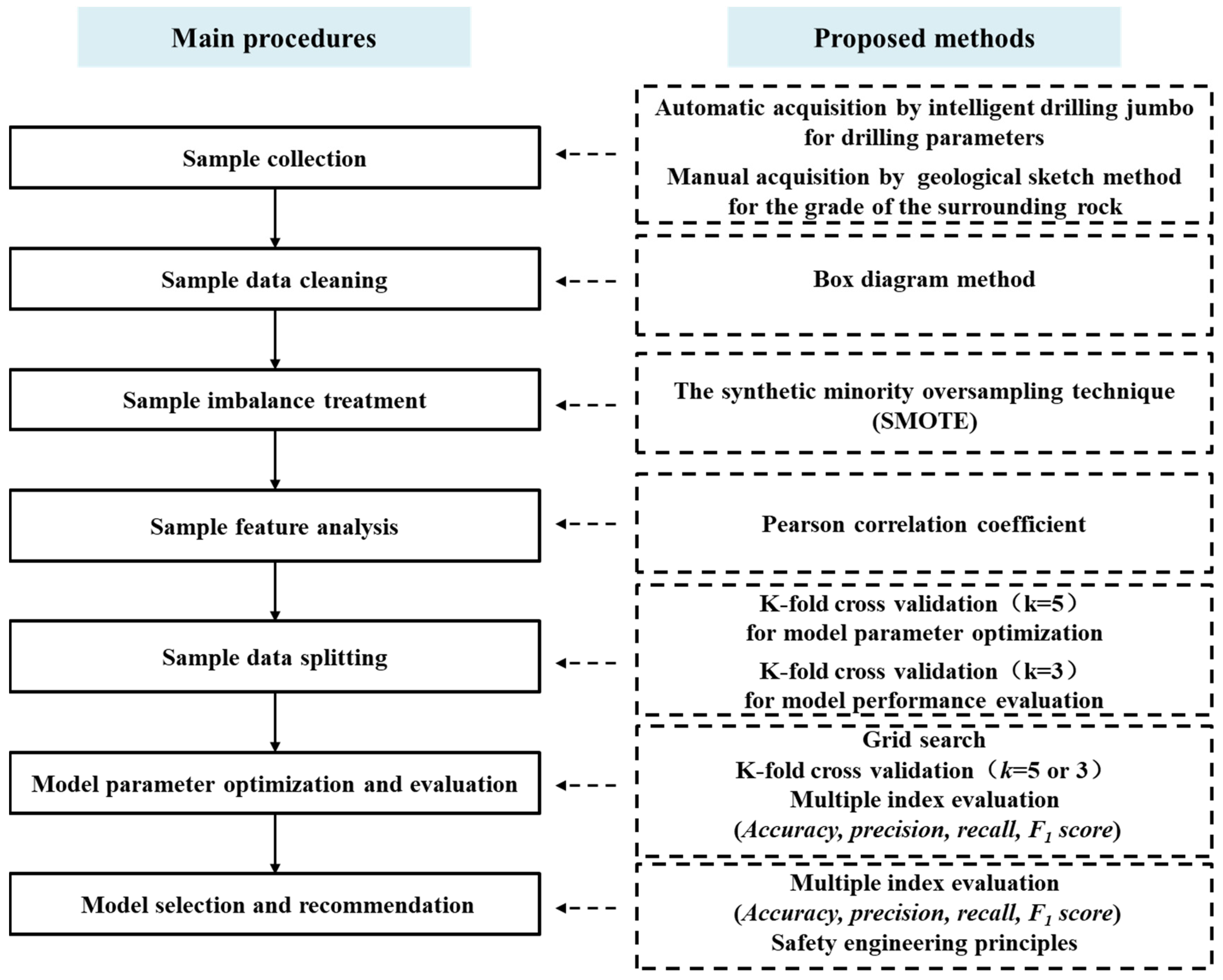
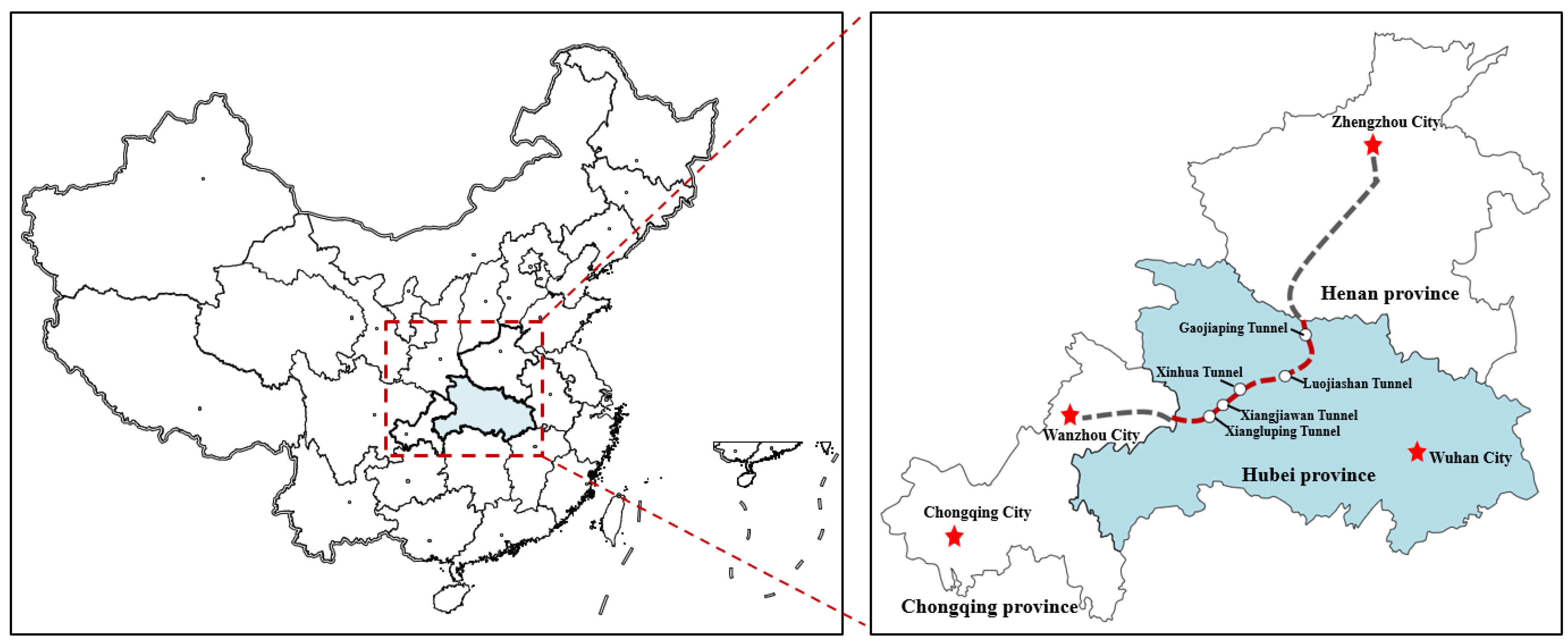
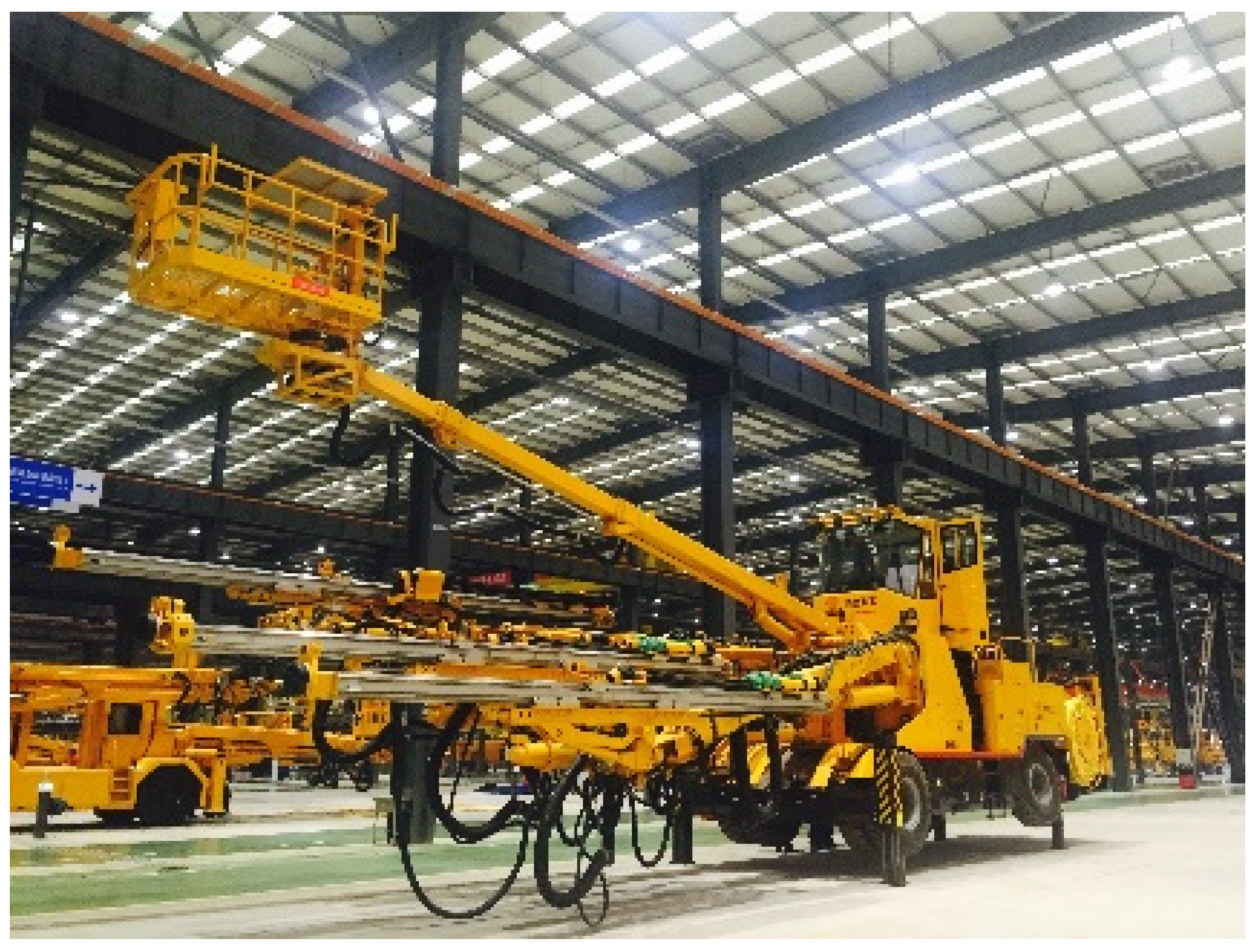
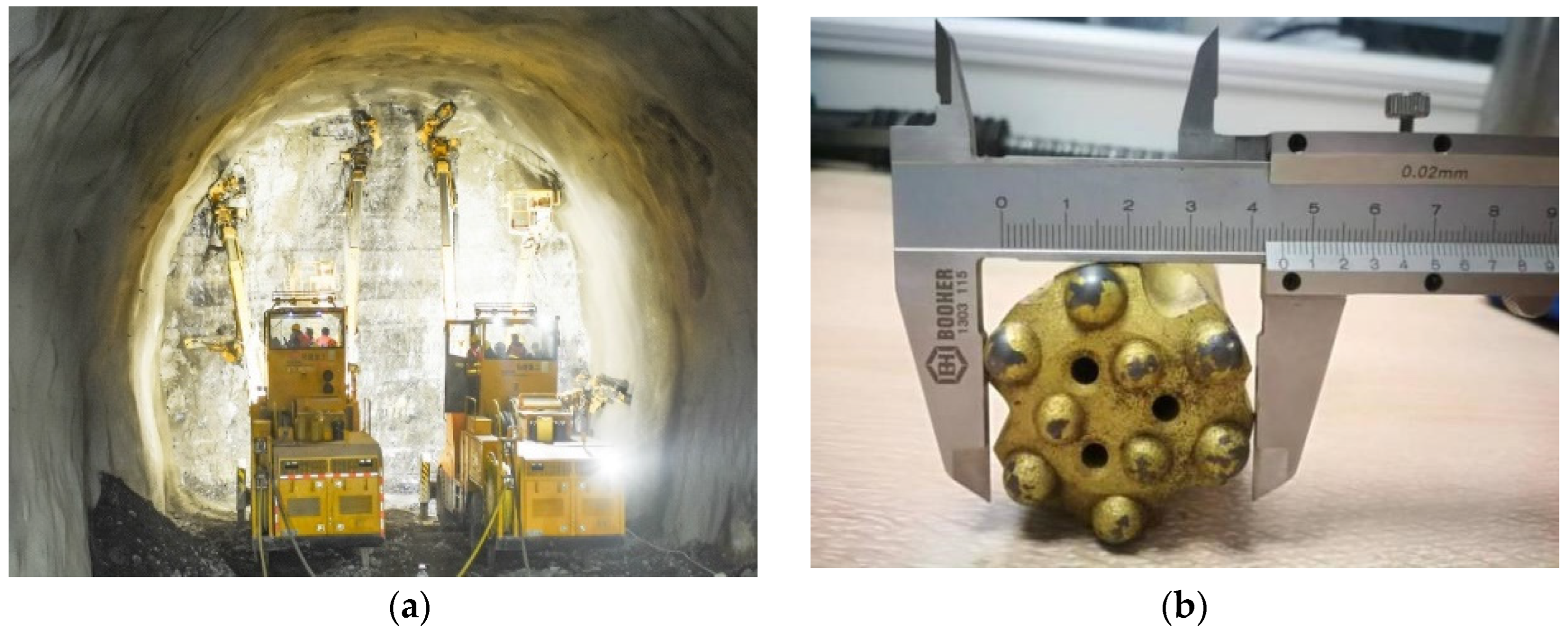
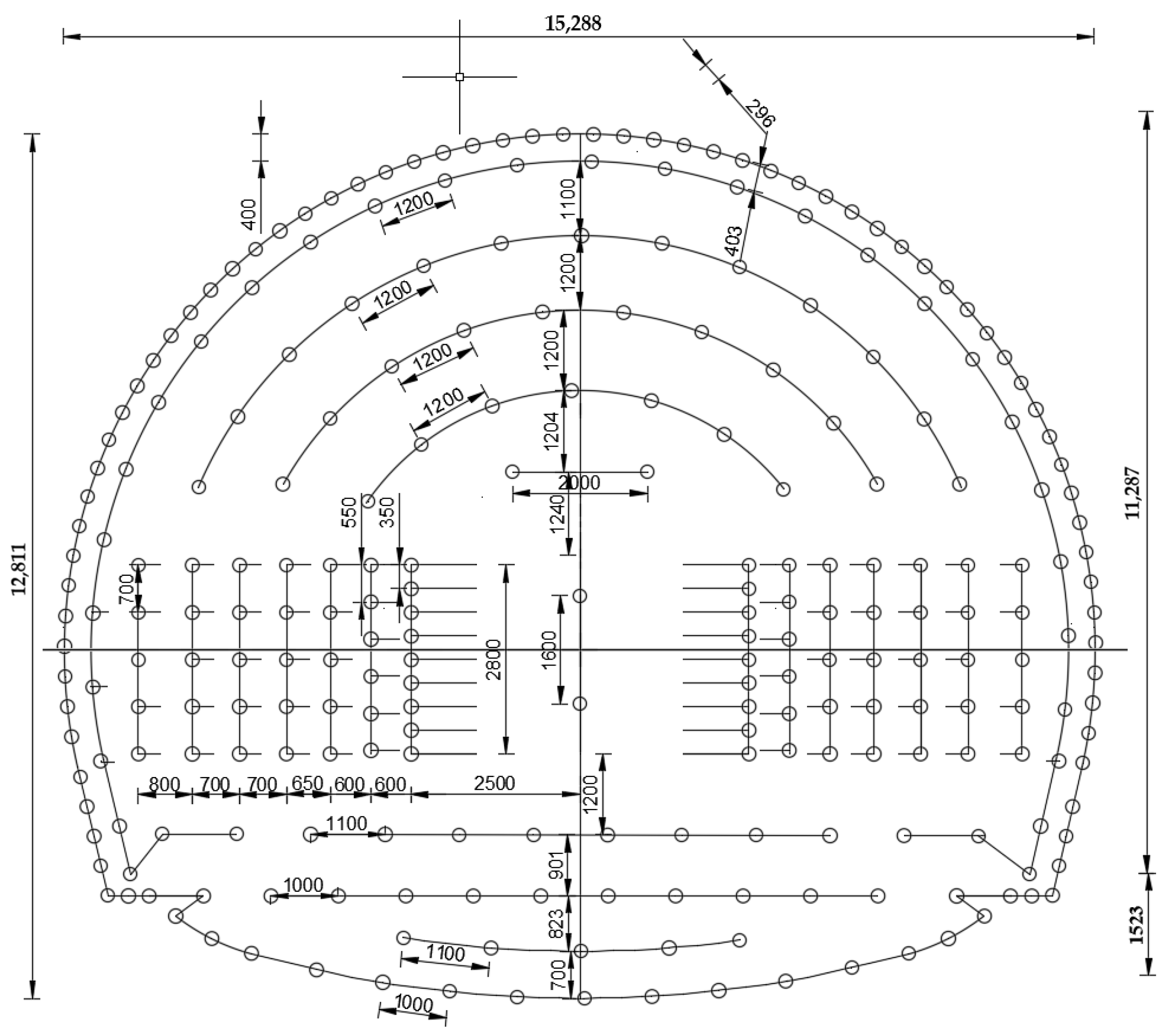
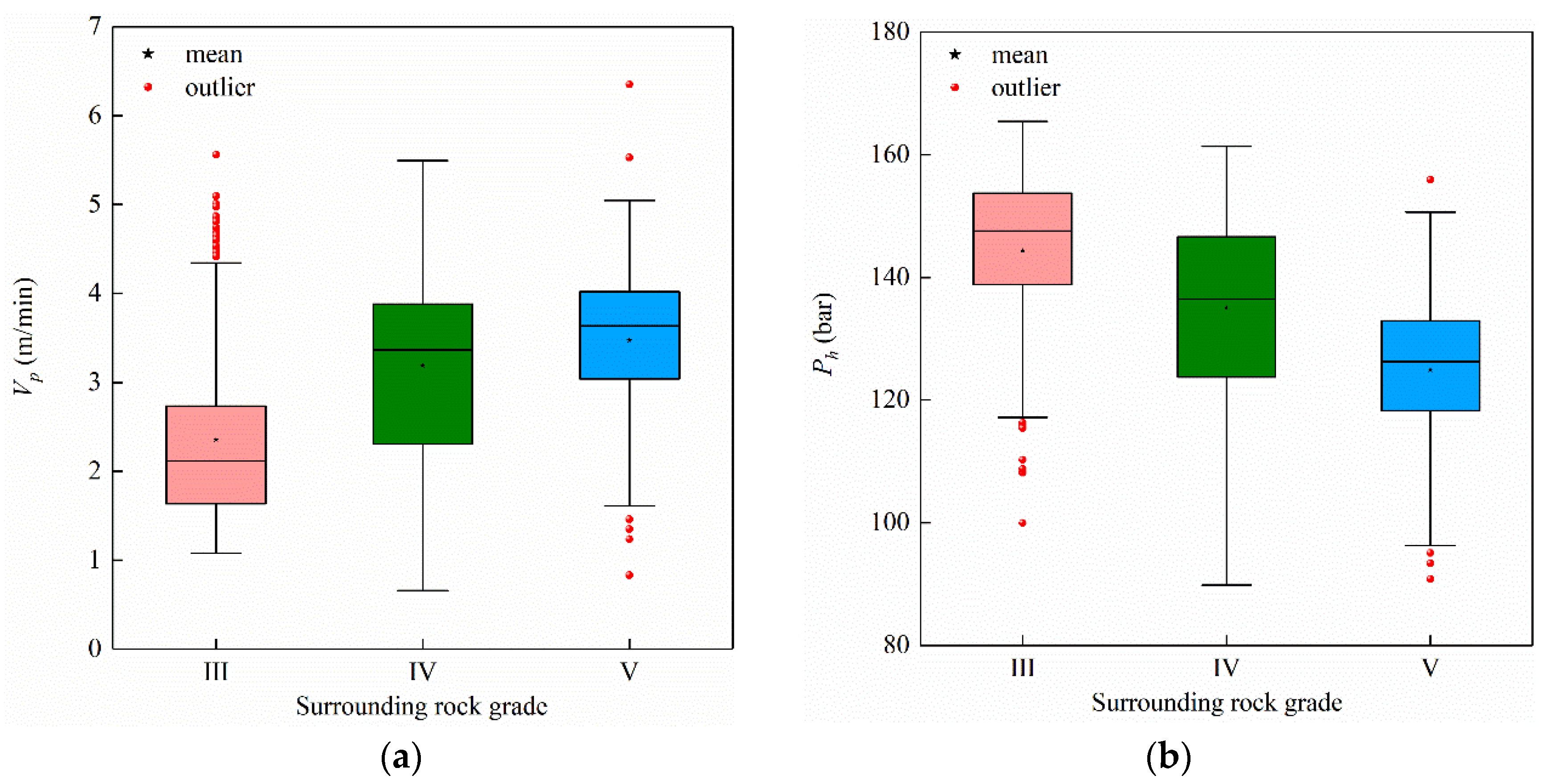
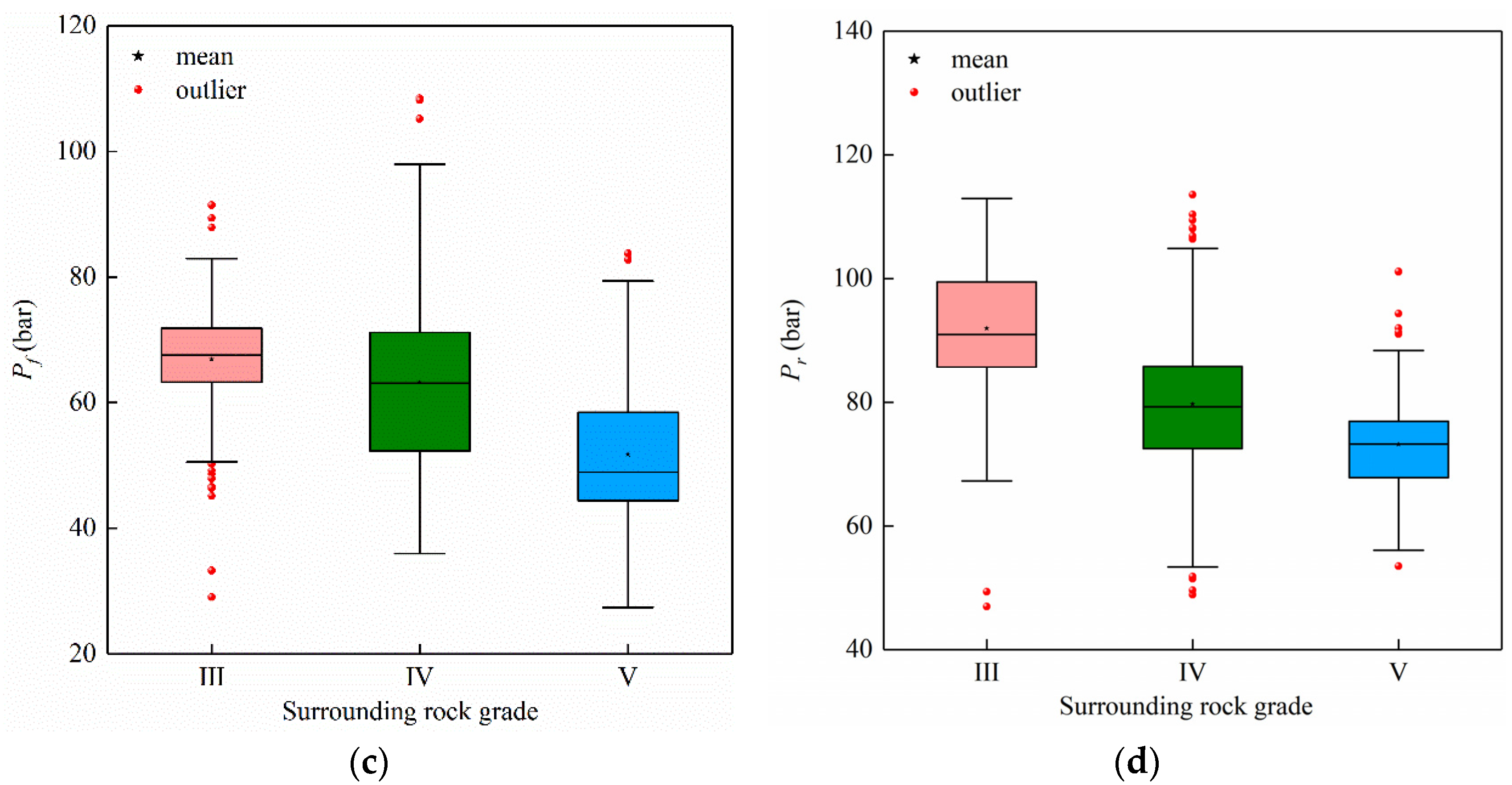
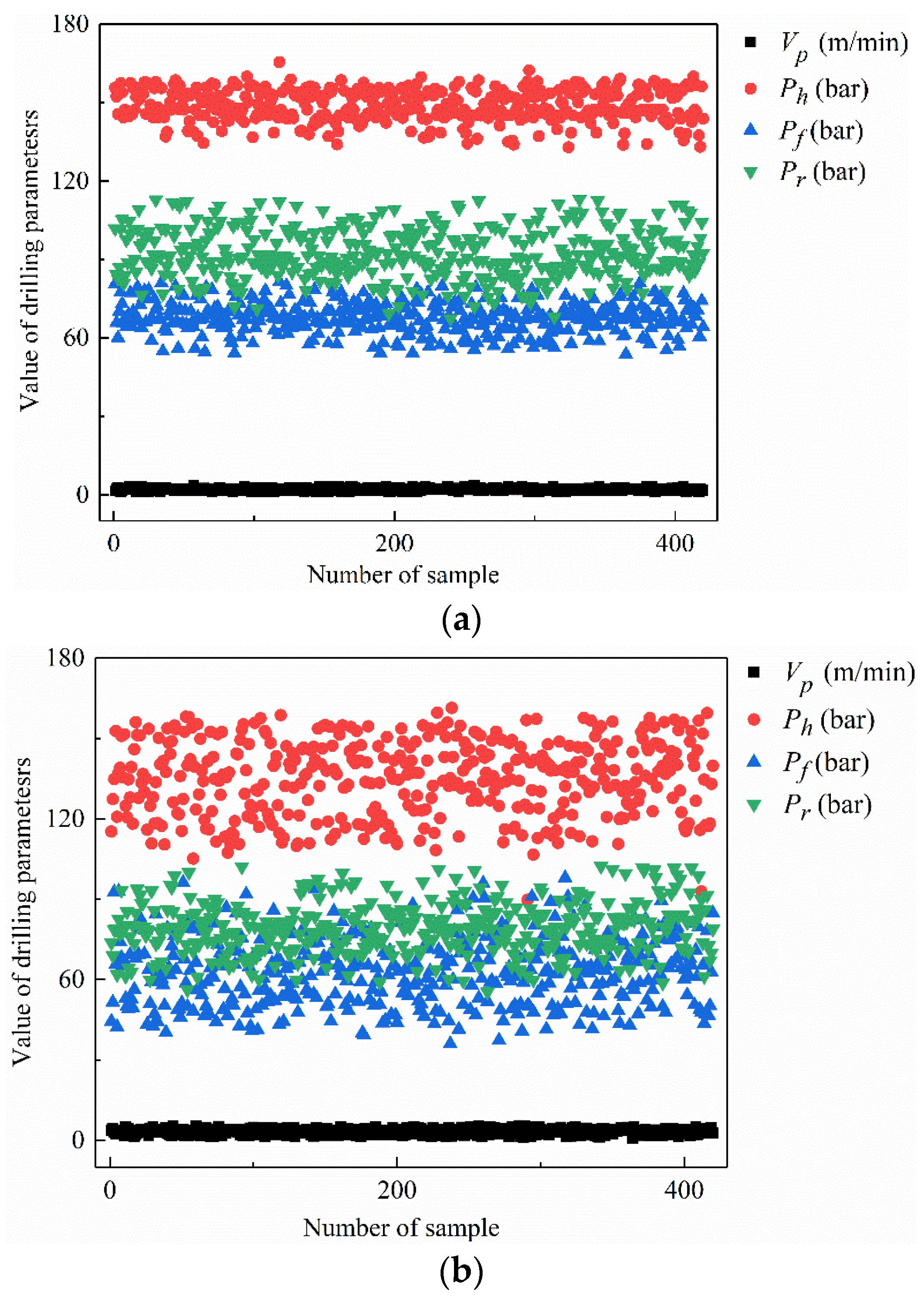
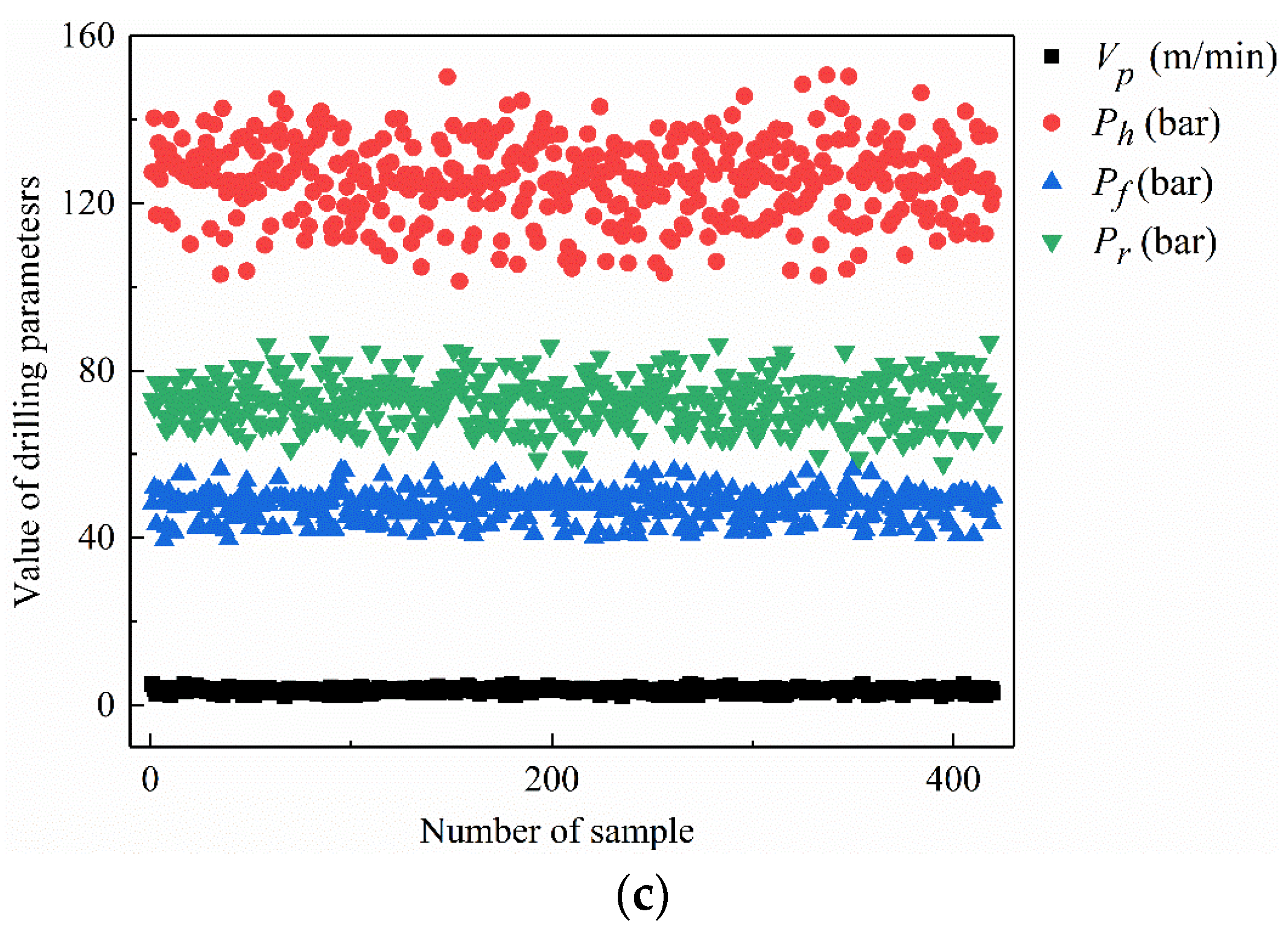
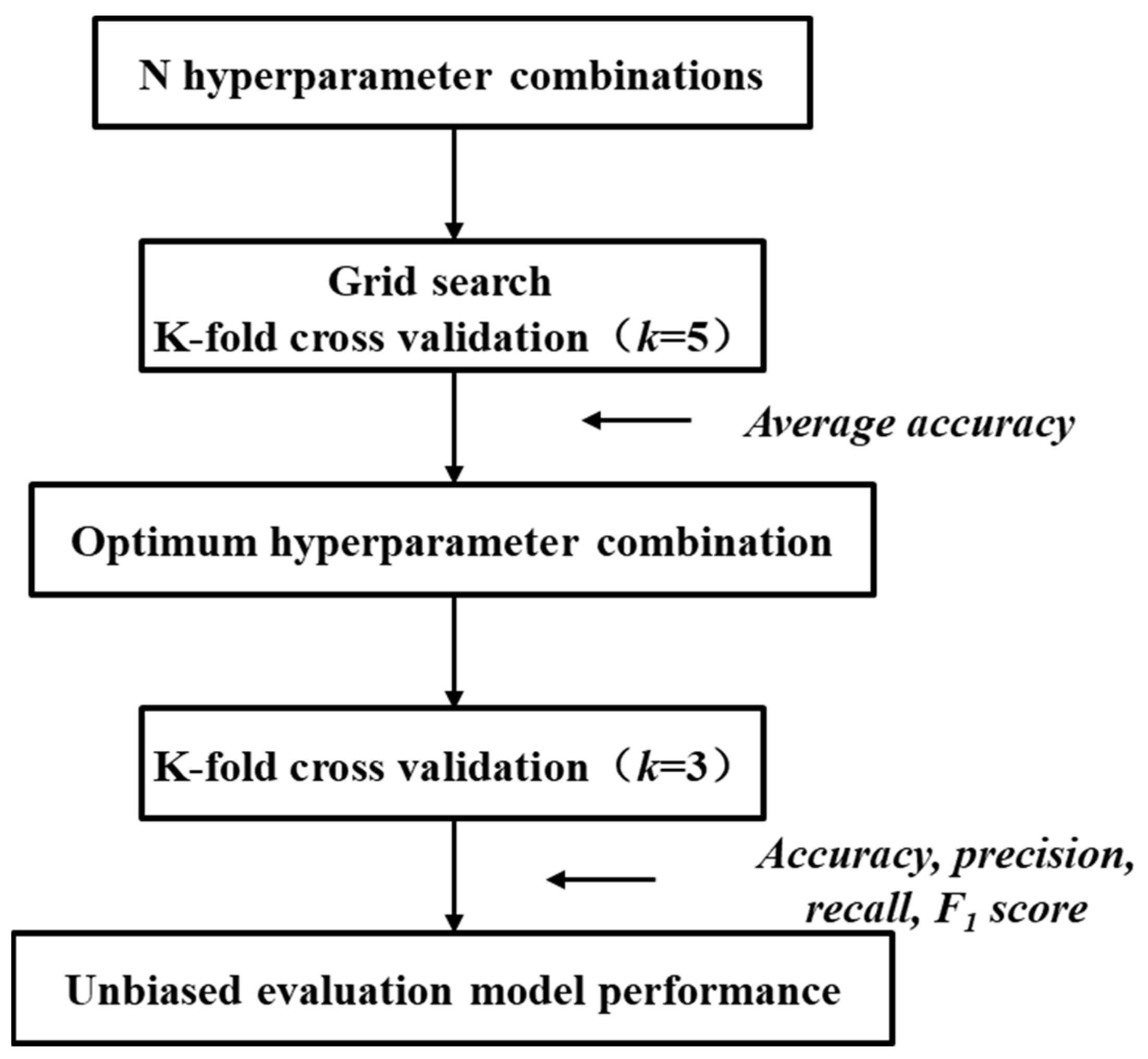

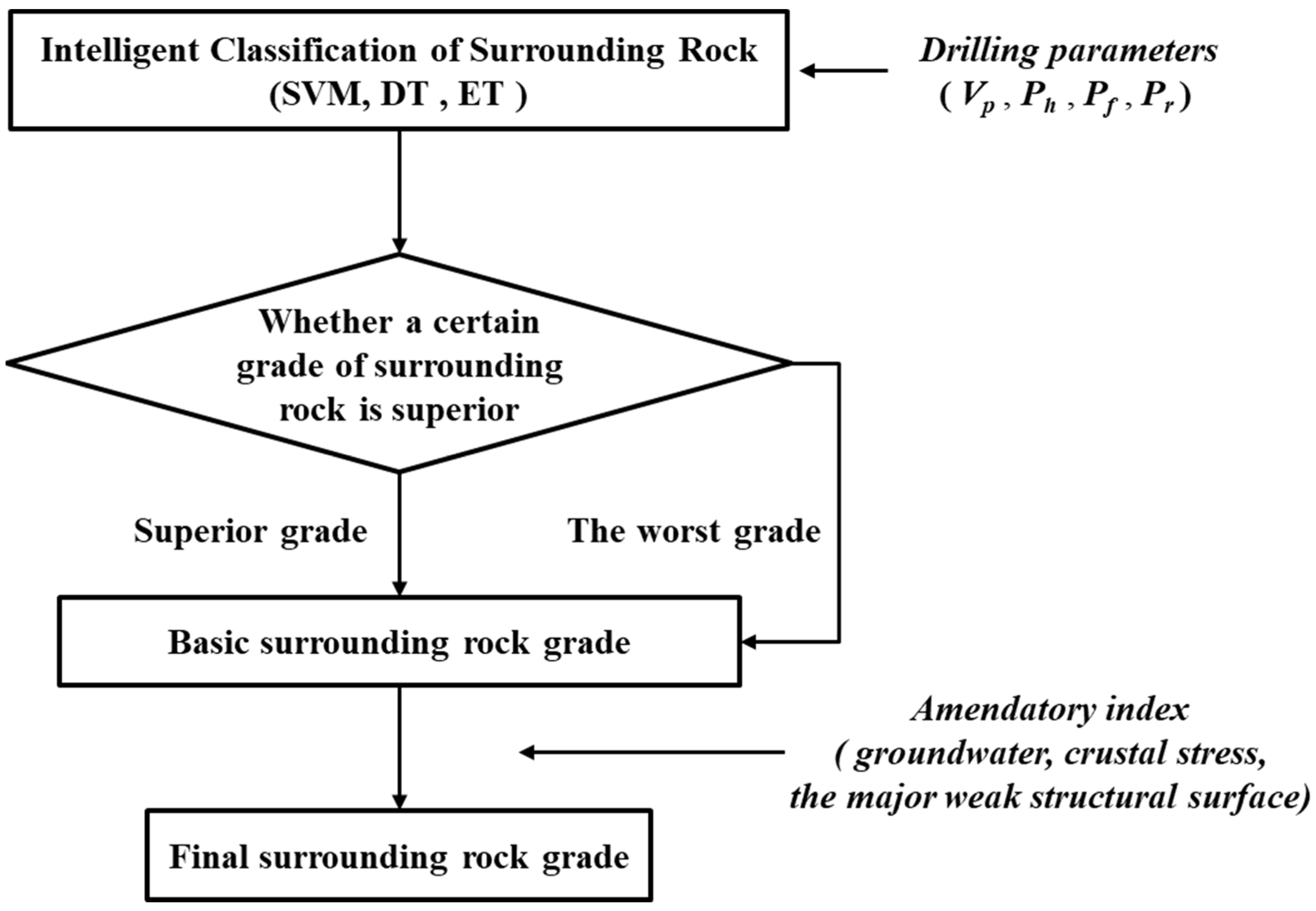
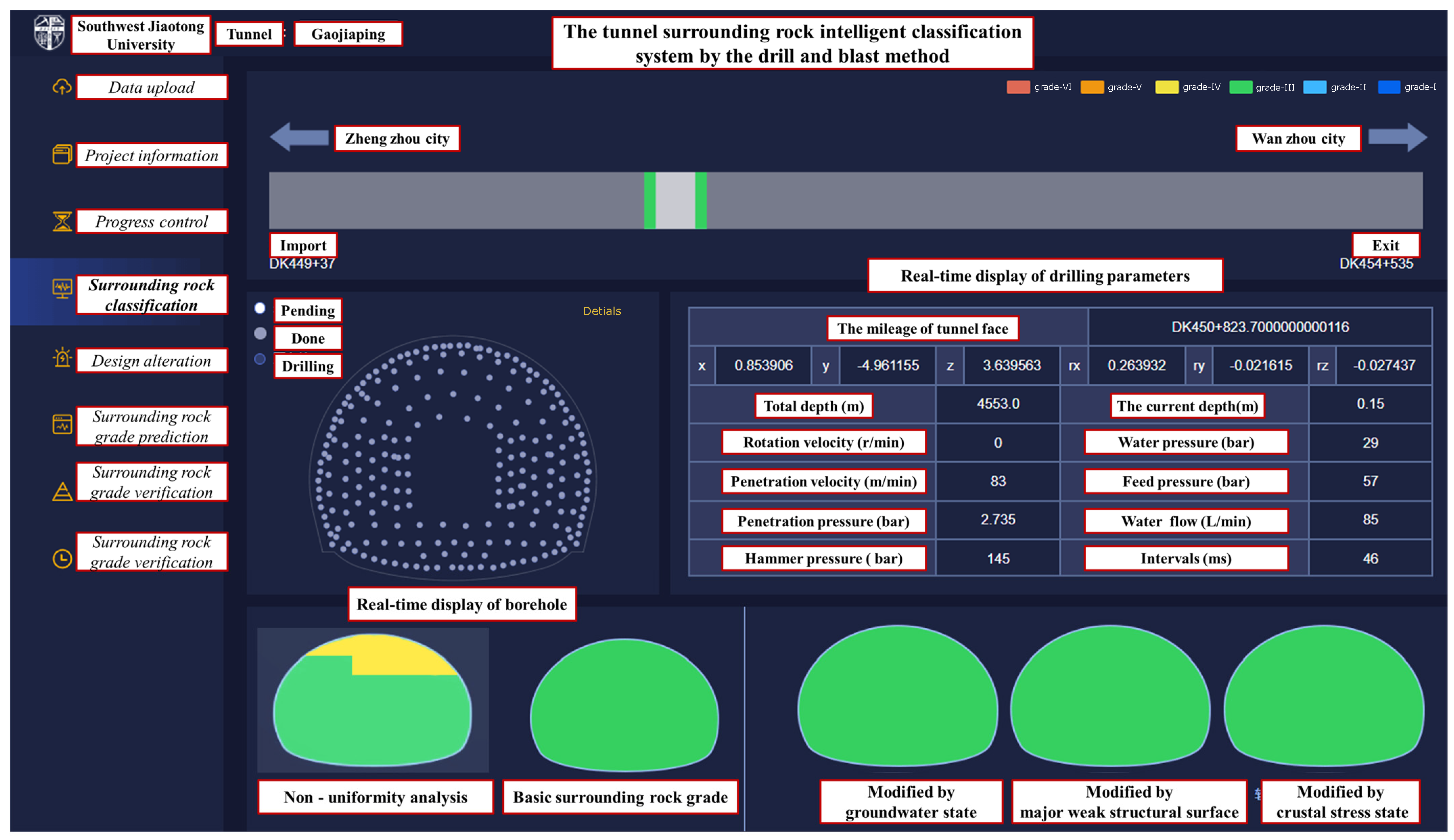

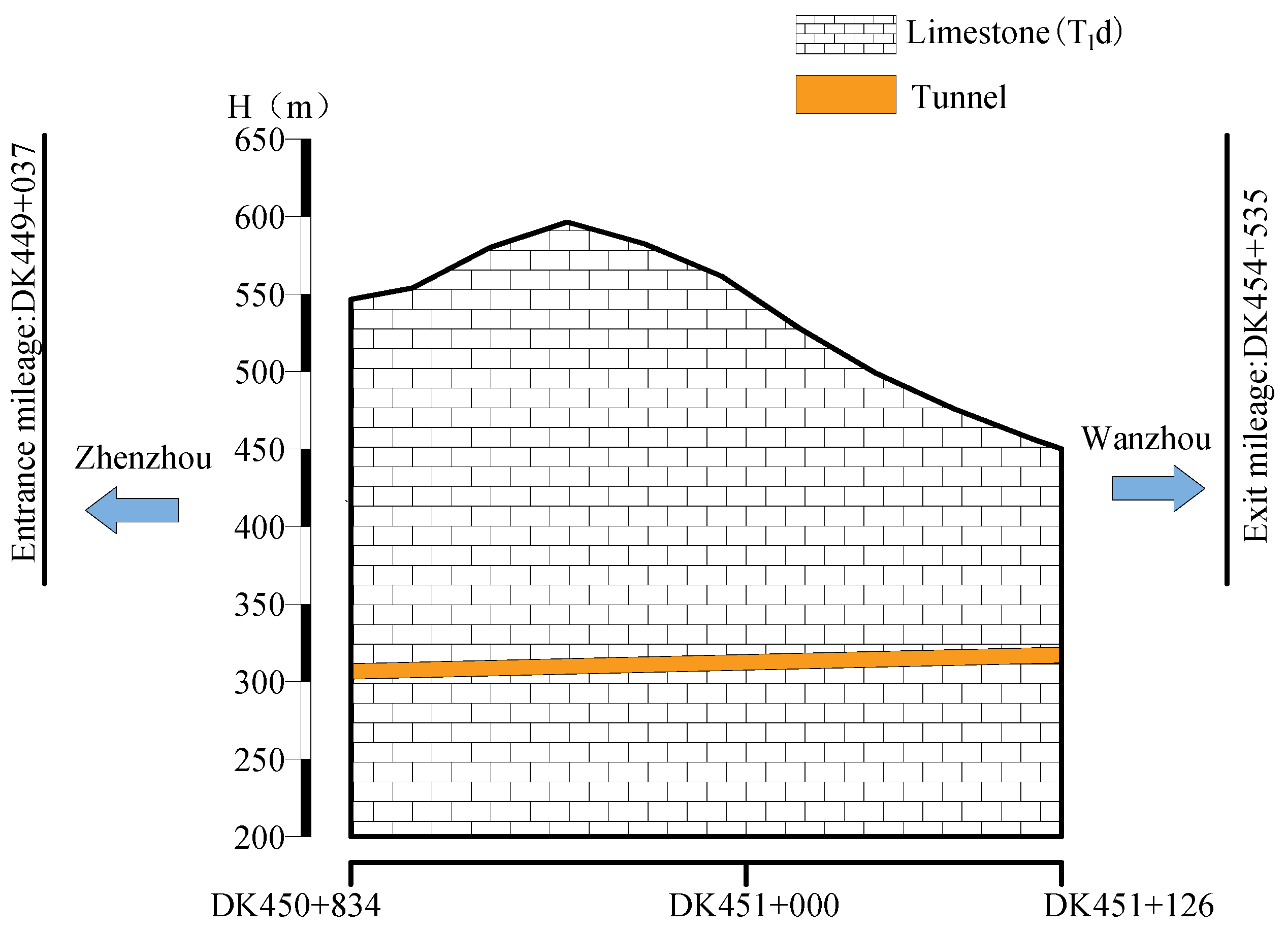

| Method | Surrounding Rock Grade | ||||
|---|---|---|---|---|---|
| I | II | III | IV | V | |
| Q value | (10,000,40) | (40,10) | (10,1) | (1,0.1) | (0.1,0.001) |
| RMR value | (100,80) | (80,60) | (60,40) | (40,20) | (20,0) |
| BQ value | (700,550) | (550,450) | (450,350) | (350,250) | (250,0) |
| The Geological Sketch Record Card of Tunnel Face | ||||||||
|---|---|---|---|---|---|---|---|---|
| Project name: XXX Mileage: XXX Date: XXX Construction unit: XXX | ||||||||
| No. | Item | State description | ||||||
| 1 | Tunnel face and support type | Width (m) | Area (m2) | Excavation method | Depth (m) | Advanced support | Primary support | Secondary lining |
| 2 | Lithology | |||||||
| 3 | Weathering degree | Slightly | Weakly | Strongly | Totally | |||
| 4 | Degree of hardness (Mpa) | Extremely hard (>60) | Hard (30~60) | Relatively soft (15~30) | Soft (5~15) | Extremely soft (<5) | ||
| 5 | Number of structural surfaces | 1 | 2 | 3 | >3 | |||
| 6 | Average spacing of the structural surface (m) | >1 | 0.4~1 | 0.2~0.4 | 0~0.2 | |||
| 7 | Degree of structural surface development | Not developed | Relatively developed | Developed | Extremely developed | |||
| 8 | Crack width (mm) | 0~1 | 1~3 | >3 | ||||
| 9 | Crack filling | None | Siliceous | Calcium | Argillaceous | Rock debris | Mud clamps rock debris | |
| 10 | Degree of structural surface bonding | Good | Fair | Poor | Extremely poor | |||
| 11 | Integrity | Integrated | Relatively integrated | Relatively broken | Broken | Extremely broken | ||
| 12 | Groundwater state | None | Drip outflow | Linear outflow | Inrush outflow | |||
| 13 | The major weak structural surface | Occurrence | Angle with tunnel axis | |||||
| 14 | Crustal stress state | Low | High | Extremely high | ||||
| 15 | Surrounding rock grade | I | II | III | IV | V | VI | |
| Tabulator: XXX Reviewer: XXX | ||||||||
| Surrounding Rock Grade | Tunnel | Lithology | Sample Size | Total |
|---|---|---|---|---|
| III | Luojiashan Tunnel | Dolomite | 110 | 325 |
| Chufeng Tunnel | Dolomite | 28 | ||
| Xinhua Tunnel | Sandstone | 31 | ||
| Xiangjiawang Tunnel | Limestone | 156 | ||
| IV | Gaojiaping Tunnel | Shale/Sandstone | 105 | 420 |
| Luojiashan Tunnel | Dolomite | 75 | ||
| Chufeng Tunnel | Dolomite | 44 | ||
| Xinhua Tunnel | Sandstone | 125 | ||
| Xiangjiawang Tunnel | Limestone | 30 | ||
| Xiangluping Tunnel | Mudstone/Sandstone | 41 | ||
| V | Gaojiaping Tunnel | Shale | 84 | 167 |
| Luojiashan Tunnel | Dolomite | 62 | ||
| Chufeng Tunnel | Dolomite | 4 | ||
| Xinhua Tunnel | Dolomite | 15 | ||
| Xiangjiawan Tunnel | Limestone | 2 | ||
| Total | 912 | |||
| Surrounding Rock Grade | Index | Vp | Ph | Pf | Pr | ||||
|---|---|---|---|---|---|---|---|---|---|
| Before | After | Before | After | Before | After | Before | After | ||
| III | mean | 2.35 | 2.04 | 144.32 | 148.85 | 66.95 | 67.69 | 91.91 | 92.18 |
| std | 0.97 | 0.51 | 12.59 | 5.98 | 8.02 | 5.91 | 10.29 | 9.69 | |
| min | 1.08 | 1.08 | 99.95 | 132.88 | 29.05 | 53.70 | 46.94 | 67.27 | |
| max | 5.56 | 3.39 | 165.41 | 165.41 | 91.45 | 81.44 | 112.97 | 112.97 | |
| IV | mean | 3.19 | 3.19 | 135.06 | 135.06 | 63.17 | 62.86 | 79.68 | 79.25 |
| std | 1.03 | 1.03 | 14.00 | 14.00 | 13.21 | 12.67 | 11.24 | 9.59 | |
| min | 0.66 | 0.66 | 89.79 | 89.79 | 35.97 | 35.97 | 48.84 | 55.38 | |
| max | 5.49 | 5.49 | 161.38 | 161.38 | 107.41 | 97.95 | 113.53 | 102.29 | |
| V | mean | 3.47 | 3.54 | 124.96 | 125.87 | 51.75 | 50.72 | 73.18 | 72.62 |
| std | 0.85 | 0.67 | 11.68 | 9.85 | 11.06 | 9.59 | 7.59 | 5.65 | |
| min | 0.83 | 1.97 | 90.82 | 101.39 | 27.43 | 27.43 | 53.47 | 57.70 | |
| max | 6.35 | 5.05 | 155.88 | 150.65 | 83.75 | 73.60 | 101.17 | 86.72 | |
| Index | Vp | Ph | Pf | Pr |
|---|---|---|---|---|
| R | 0.59 | −0.64 | −0.52 | −0.65 |
| Item | Surrounding Rock | ||||
|---|---|---|---|---|---|
| III | IV | V | Total | ||
| Validation process | Training set | 336 | 336 | 336 | 1008 |
| Prediction set (Validation set) | 84 | 84 | 84 | 252 | |
| Testing process | Training set | 280 | 280 | 280 | 840 |
| Prediction set (Testing set) | 140 | 140 | 140 | 420 | |
| Performance Index | Rock Grade | Supervised Learning Algorithm | Average | |||||||||
|---|---|---|---|---|---|---|---|---|---|---|---|---|
| SVM | BP | RBF | KNN | GNB | DT | RT | ET | Bag-ging | GB | |||
| Precision | III | 0.81 | 0.79 | 0.73 | 0.77 | 0.75 | 0.75 | 0.81 | 0.80 | 0.80 | 0.81 | 0.78 |
| IV | 0.90 | 0.87 | 0.76 | 0.84 | 0.75 | 0.59 | 0.85 | 0.88 | 0.83 | 0.87 | 0.81 | |
| V | 0.86 | 0.88 | 0.87 | 0.90 | 0.82 | 0.84 | 0.90 | 0.92 | 0.91 | 0.88 | 0.88 | |
| Recall | III | 0.96 | 0.97 | 0.94 | 0.93 | 0.91 | 0.73 | 0.92 | 0.94 | 0.93 | 0.96 | 0.92 |
| IV | 0.62 | 0.61 | 0.52 | 0.63 | 0.50 | 0.60 | 0.67 | 0.67 | 0.67 | 0.65 | 0.61 | |
| V | 0.97 | 0.94 | 0.89 | 0.94 | 0.92 | 0.86 | 0.96 | 0.96 | 0.93 | 0.94 | 0.93 | |
| F1 score | III | 0.88 | 0.87 | 0.82 | 0.84 | 0.82 | 0.74 | 0.86 | 0.87 | 0.86 | 0.88 | 0.84 |
| IV | 0.73 | 0.72 | 0.62 | 0.72 | 0.60 | 0.59 | 0.75 | 0.76 | 0.74 | 0.75 | 0.70 | |
| V | 0.91 | 0.91 | 0.88 | 0.92 | 0.87 | 0.85 | 0.93 | 0.94 | 0.92 | 0.91 | 0.90 | |
| Accuracy | - | 0.85 | 0.84 | 0.78 | 0.84 | 0.78 | 0.73 | 0.85 | 0.86 | 0.84 | 0.85 | 0.82 |
| Number | Mileage | Predicted Results | Actual Results | Right/Error |
|---|---|---|---|---|
| 1 | DK450+834 | III | III | Right |
| 2 | DK450+837 | III | III | Right |
| 3 | DK450+840 | III | III | Right |
| 4 | DK450+916 | III | III | Right |
| 5 | DK450+919 | III | III | Right |
| 6 | DK450+922 | III | III | Right |
| 7 | DK450+926 | III | III | Right |
| 8 | DK451+014 | III | III | Right |
| 9 | DK451+017 | III | III | Right |
| 10 | DK451+021 | III | III | Right |
| 11 | DK451+024 | III | III | Right |
| 12 | DK451+027 | III | III | Right |
| 13 | DK451+030 | III | III | Right |
| 14 | DK451+034 | III | III | Right |
| 15 | DK451+037 | III | III | Right |
| 16 | DK451+042 | III | III | Right |
| 17 | DK451+046 | III | III | Right |
| 18 | DK451+051 | III | III | Right |
| 19 | DK451+055 | III | III | Right |
| 20 | DK451+060 | III | III | Right |
| 21 | DK451+064 | III | III | Right |
| 22 | DK451+100 | III | III | Right |
| 23 | DK451+103 | III | III | Right |
| 24 | DK451+106 | III | III | Right |
| 25 | DK451+109 | III | III | Right |
| 26 | DK451+113 | IV | III | Error |
| 27 | DK451+116 | IV | III | Error |
| 28 | DK451+119 | IV | III | Error |
| 29 | DK451+123 | IV | III | Error |
| 30 | DK451+126 | III | III | Right |
| Accuracy | 86.7% | |||
Publisher’s Note: MDPI stays neutral with regard to jurisdictional claims in published maps and institutional affiliations. |
© 2022 by the authors. Licensee MDPI, Basel, Switzerland. This article is an open access article distributed under the terms and conditions of the Creative Commons Attribution (CC BY) license (https://creativecommons.org/licenses/by/4.0/).
Share and Cite
Zhao, S.; Wang, M.; Yi, W.; Yang, D.; Tong, J. Intelligent Classification of Surrounding Rock of Tunnel Based on 10 Machine Learning Algorithms. Appl. Sci. 2022, 12, 2656. https://doi.org/10.3390/app12052656
Zhao S, Wang M, Yi W, Yang D, Tong J. Intelligent Classification of Surrounding Rock of Tunnel Based on 10 Machine Learning Algorithms. Applied Sciences. 2022; 12(5):2656. https://doi.org/10.3390/app12052656
Chicago/Turabian StyleZhao, Siguang, Mingnian Wang, Wenhao Yi, Di Yang, and Jianjun Tong. 2022. "Intelligent Classification of Surrounding Rock of Tunnel Based on 10 Machine Learning Algorithms" Applied Sciences 12, no. 5: 2656. https://doi.org/10.3390/app12052656
APA StyleZhao, S., Wang, M., Yi, W., Yang, D., & Tong, J. (2022). Intelligent Classification of Surrounding Rock of Tunnel Based on 10 Machine Learning Algorithms. Applied Sciences, 12(5), 2656. https://doi.org/10.3390/app12052656





